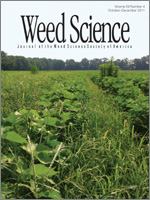Purple nutsedge is a troublesome C4 weed, characterized by high photosynthetic efficiency, compared to C3 weeds. As its dispersal is based on vegetative growth, accurate prediction of its growth could help in arriving at favorable management decisions. This article details the development and validation of predictive models of purple nutsedge spatial growth, based on temperature (thermal model), and temperature and radiation (photothermal model) measurements. Plants were grown in six experiments in the summers of 2008, 2009, and 2010, under different temperature and radiation conditions. Results indicate that under optimal temperatures, radiation becomes the main growth-limiting factor, and is highly related to the final leaf-cover area (R2 = 0.89). Comparison of the thermal and photothermal models showed that under all conditions, including varied temperature and radiation, the photothermal model performs significantly better, with differences in root-mean-square error values reaching up to 0.073, compared to 0.195 with the thermal model. Validation experiments confirmed the ability of the photothermal model to predict purple nutsedge spatial growth accurately.
Nomenclature: Purple nutsedge, Cyperus rotundus L. CYPRO.





